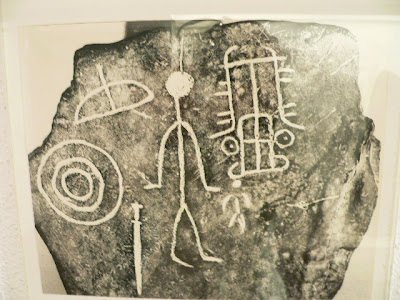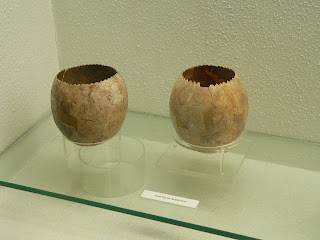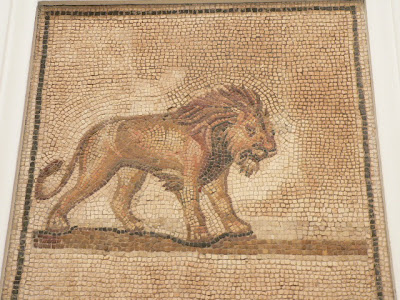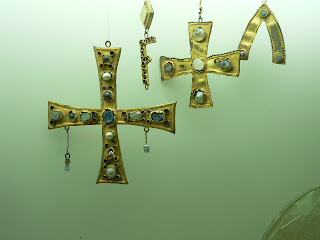Seville has been described as the artistic, cultural, and financial capital of Southern Spain; it's been around for 2,000 years so it's had time to practice!
Here is their art:
This is what to look for:
Oops! Here's Baby-O plopped a bit too close to another (priceless) piece of art eating her raisins! Do you see the circle pattern on the other side this time?
The people during this time created and used simple stone tools. We evolved from them into Homo Sapien Sapiens (Latin for "wise man" or "knowing man"). You'll see a picture of our earlier ancestors in J's post coming up--- he'll also show you how stones could be lethal. Simple tools? Not so fast. Stones could be weapons that were made to be deadly. How? A flint knapper! Click back there to find out how. J's got a great story about an arrowhead stuck in the neck of one of these people and the picture to go with it!
If you get interested in Stone Age Tools, follow this cool blog to learn more and keep up with new discoveries.
Next came the Copper and Bronze Age. Pottery began around 6000 B.C. By the beginning of the Bronze Age (3,000 B.C) these folks began using a 'slow' potter's wheel.
New kinds of weapons came too.
Here are the kids looking at tools for melting metals together. They were learning about the difference between copper, bronze and iron and what happens when you mix metals together.
Here's what the process was about. Look at the long rods you see in the image below. Now scroll back up to the previous picture. Do you see the pile in front of J. and Gigi? That's them!
Here is how they made axe heads; there was a big pile of them next to this mold. Can you see where they would pour the metal into the mold?
Next we entered a dark room full of sacred objects and GOLD. It felt like the Pink Panther might not be too far away. . .
These objects were devoted to Tartessian treasures. The name didn't mean much to me but Aristotle himself wrote about the Tartessos as a river that flowed out to the pillars of Hercules or, what we call the Straits of Gibraltar. Turns out the tale is a great bit 'Indiana Jones-esque' because people have hunted for the capital city and no one knows exactly where it lies.
Some believe it may be lost and buried, some say it's another Atlantis or the Atlantis- the one Plato wrote about! Why do people care? Gold and silver and lots of it, and of course, understanding the culture better.
Baby-O was getting tired right about now so I couldn't take pictures of all the silver and gold jewelry laid upon velvet under blinding lights. I was shocked to learn later that Tartessian language is classified as a Celtic language. Even that idea is contested though. Looks like the mysteries about this wealthy civilization remain to be solved, maybe by YOU?
HOLD THE PRESSES! You won't believe it but on January 19th (the day we saw the archeology sites in Orce) an article entitled, 'Lost City of Atlantis 'could be buried in southern Spain' was published in the United Kingdom's Telegraph newspaper! Scientists have figured out that a tsunami might have wiped away the capital of this wealthy civilization! Keep an eye on this one, it looks like it might unfold during your lifetime.
If this interests you I found a fabulous blog that links ancient history to today. The author's latest posts are on "Mysteriously Missing Persian Army Believed Found" and "Irish Monks in Iceland Even Before Vikings?" Great stuff! You can subscribe to 'follow' the blog like you can to ours, that way you'll receive an email every time there is a new post.
You can see how exciting this all gets. . .here are some OSTRICH EGGS!
Belt buckles!
These ingenius looking things are called 'ex-votos' Baby-O called them 'dolls'. They were made by relatives of the Tartessian's called the Turdetanians. Try saying that out loud. That name would have a PROBLEM in English!
All that gold and silver attracted Phoenician traders---here's a trove of coins. There were horses and other figures clearly visible on this money. Did you know thePhoenician's invented metal money in 1500 B.C. when they discovered a way to carry their cattle along to trade?
We reached the Roman sculptures and were wowed all over again. The scale of Roman sculpture is astounding.
It's. . .likeness well. . .enough to make you grin! Gigi was laughing about taking this shot but I told her people would want to see it!
The next picture is a sculpture of the Roman Emperor, Trajan. He was known as 'the kind-hearted soldier' because he created funds to look after the poor and for children. Trajan was famously wise and humble but he was also a military giant. He conquered north of the river Danube and grew the Roman Empire to its largest extent. This sculpture of him was mammoth in size (we had to crane up) but what was mesmerizing about it was his face.
It looked so real I thought he might turn and say something.
The mosaics were as fresh and vivid as if conceived of today.
It felt like we were peeking into a Roman life.
Here's a doctor's kit (the metal box) and the medical tools.
A Roman key.
A Roman mirror.
Roman jewelry:
I wish we could speak Latin (we are going to study it this second part of the trip, we start tomorrow). What do you think this says?
The Romans might have lived 2,000 years ago but their light shines on. . .literally.
First kid-friend to send a short essay on how Roman civilization still impacts us today wins a souvenir from Morocco. J has Evan's sensational answers to the last challenge, I will post them as soon as I can.
We leave on a plane tomorrow for Marrakech- farewell until Africa!































No comments:
Post a Comment